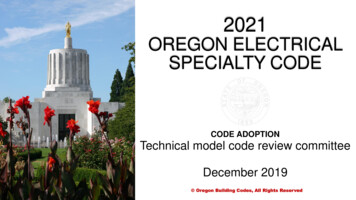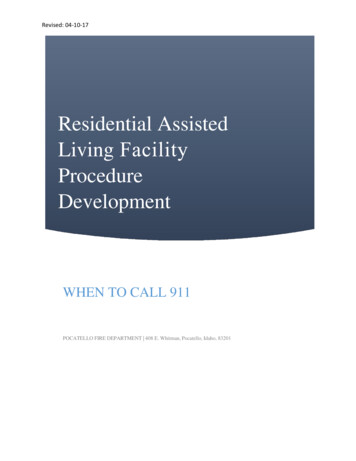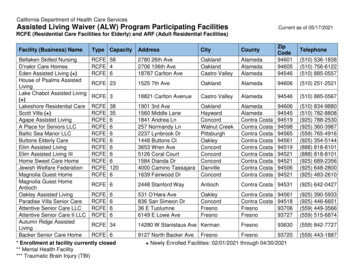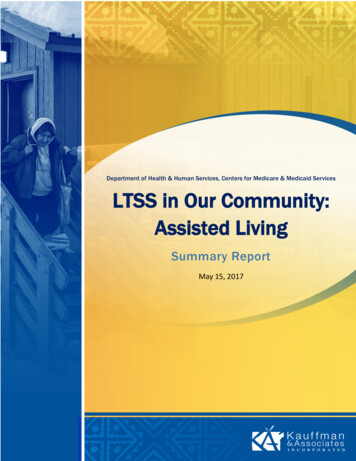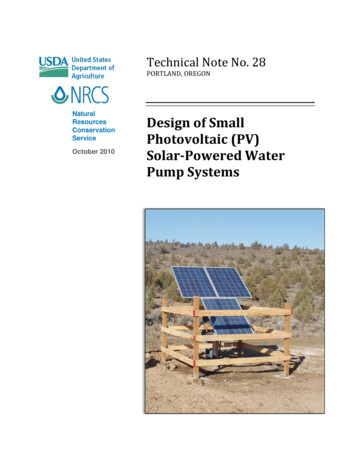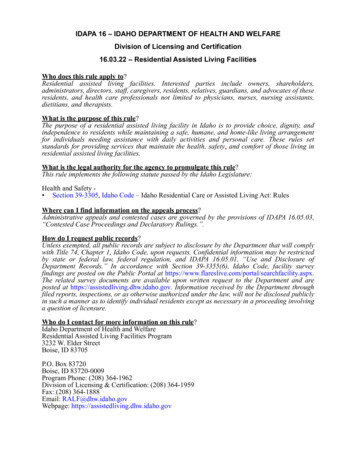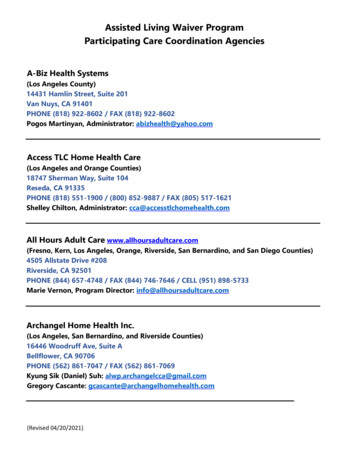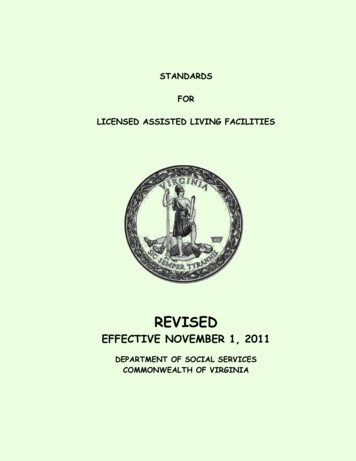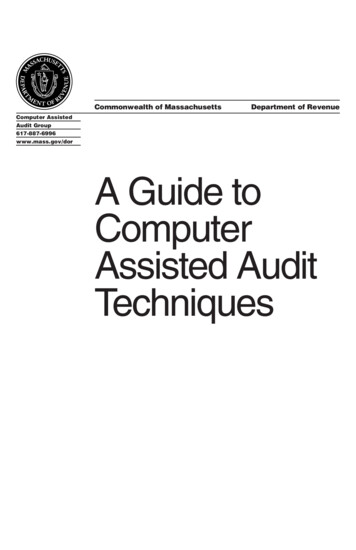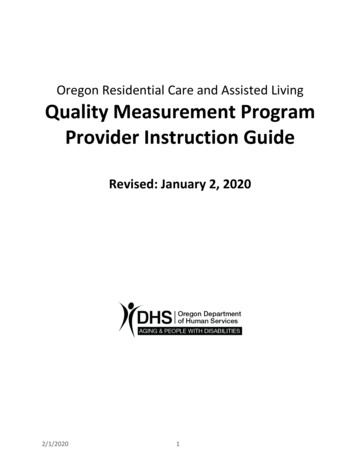
Transcription
Oregon Residential Care and Assisted LivingQuality Measurement ProgramProvider Instruction GuideRevised: January 2, 20202/1/20201
Oregon’s Residential Care and Assisted Living QualityMeasurement ProgramBackground:In 2017, the Oregon Legislative Assembly passed House Bill 3359 (now ORS 443.447),which: Created the Residential Care and Assisted Living Quality Measurement Program; Established a governor-appointed Quality Measurement Council staffed by theDepartment of Human Services (DHS); Directed the Council, in consultation with DHS, to develop a uniform qualitymetrics reporting system to measure and compare the performance ofresidential care and assisted living facilities across the state; Requires that each residential care facility (RCF) and assisted living facility (ALF)annually submit quality metrics data; and Requires DHS publish an annual report, based on data reported by each RCF/ALF.The Council is responsible for detailing the operationalization of the measurementprogram while limiting the burden to facilities in tracking and reporting data as muchas possible. Members of the Council are listed below.Required representatives:Oregon Patient Safety CommissionAppointed members:Sydney E. Edlund, MS, Director of Research and Analytics,Oregon Patient Safety CommissionResidential care facilitiesrepresentativeMauro L. Hernandez, PhD, Principal, ita partnersAlzheimer’s advocacy organizationSara E. Kofman, Public Policy Director, OregonAlzheimer’s AssociationPractitioner with geriatricexperienceDr. Maureen Nash, MD, MS, FAPA, FACP, MedicalDirector, Providence ElderPlace OregonAcademic representative withexpertiseAcademic representative withexpertisePaula Carder, PhD, Portland State UniversityCarolyn A. Mendez-Luck, PhD, MPH, Oregon StateUniversityLong Term Care OmbudsmanFred Steele, JD, MPH, State Long-Term Care OmbudsmanDepartment representativeAnn McQueen, PhD, MS, Research and Policy IntegrationManager, Office of Aging and People with Disabilities,Oregon Department of Human Services2/1/20202
Responsibility of RCFs and ALFs to report metrics annually:By law, all residential care and assisted living facilities (including those with memory careendorsements) are required to track and report annually on the following quality metrics:1. Retention of direct care staff,2. Compliance with staff training requirements,3. Incidence of falls with injury,4. Use of antipsychotic medications for nonstandard purposes, and5. Results of annual resident satisfaction survey conducted by a third party.Each RCF and ALF shall submit the required quality metrics data to the Department using aweb-based Quality Metrics Application (the “QMA” or “App”). The first reporting cycle willbegin with facilities tracking 2020 data and reporting it via the App in early in 2021.Metrics data will then continue to be required by January 31 st of each year after that for theprevious year’s data.This Guide:This Guide was created to give facilities the background information and instructionsneeded to successfully track and report all data that is required by law. It containsinformation about the reasons for collecting data related to each metric, as well as detailsabout how and what data to collect and the frequency that data needs to be collected.In addition to this Guide, the Department and partners will conduct a series of trainings,including webinars that will be posted on the Community Based Care provider es.aspx.The chart below shows important dates to note:Tracking Year for FacilitiesProvider Deadline forEntering Data into the AppData Reported by DHS toFacilities and PublicCalendar Year 2020January 31, 2021July 1, 2021Calendar Year 2021January 31, 2022July 1, 2022Calendar Year 2022January 31, 2023July 1, 2023Calendar Year 2023January 31, 2024July 1, 20242/1/20203
The following chart indicates the frequency and duration of time that each of the qualitymetrics is to be tracked in 2020:Metric#12345Metric NameRetention of DirectCare StaffData Collection FrequencyOnce, after 12/31/20 (for 2020)Once, after 12/31/20 (for 2020);Compliance with Staffmonthly tracking tool isTraining Requirementsavailable/recommended.Number of ResidentMonthly, from 7/1/2020 toFalls with Injury12/31/2020*Use of AntipsychoticReport daily for all 31 days ofMeds for NonOctober 2020.standard UseResults of AnnualOnce, between 1/1/20 andSatisfaction Survey by12/31/203rd partyDuration of TimeFull calendar yearFull calendar yearLast six months ofcalendar year*31 days (October ofeach year)Once a year, at anytime* For the first year of the Quality Measurement Program, providers must only report data forMetric 3 for the last six months of the year. In subsequent years, providers will be expectedto report data for all 12 months of the year.Annual Report:The Department will compile the information received from all residential care facilities andassisted living facilities and publish an annual report describing statewide patterns andtrends. This report will be available online to be used by facilities and the general public toevaluate and compare facilities. Quality metrics data will eventually be posted as part ofeach facility’s record on the Long-term Care Settings Search Tool website:https://ltclicensing.oregon.gov/Please note:New facilities that open during 2020 are not required to submit any metrics data for 2020.These new facilities will be required to track data beginning in 2021 and will have to enterdata into the App by January 31, 2022.Questions and Contacts:We encourage you to familiarize yourself with the information in this Guide and refer backto it whenever you have questions. If you still have questions after referring to this Guide,please contact your assigned policy analyst within the Office of Safety, Oversight and Qualityor send your question to the Community-Based Care Team via email 204
Step 1: Access the Long-term Care Facility Portal Open your browser and go to the Long-term Care Facility Portal website at:https://ltcfacilityportal.oregon.gov/ Click “Register” at the top right corner of the screen.2/1/20205
Step 2: Enter Information to Request an Account Enter your information in all of the required fields. Choose and confirm a secure password you will remember. Click the green “Add facility” button to search for your facility from the listof licensed facilities.2/1/20206
Step 3: Search for Your Facility Type your facility’s name into the “Search” field or use the page selectionfeature to find the facility you are associated with. If you will be entering data for more than one facility, the application willlet you add more facilities using the same process described above.2/1/20207
Step 4: Submit Your Account Registration Request Once you have selected the facility or facilities you will be entering data for,click the blue “Register” button on the left side of the screen.o This will send an auto-generated request for account approval to theSafety, Oversight and Quality Unit. The approval process may takeone to three (1-3) business days.o You will also receive an auto-generated email at the address youprovided requesting that you verify your email address. Please do soas soon as possible.2/1/20208
Step 5: Sign In to Your Account One to three (1-3) business days after submitting your request for anaccount (Step 4), visit the application website again at:https://ltcfacilityportal.oregon.gov/ Click “Log In” at the top right corner of the page. Enter the email address and password you used to register for your accountin Step 2. Click the green “Sign in” in the middle of the page.2/1/20209
Step 6: Select the Quality Metrics Application Once you have successfully logged in to the Long-term Care Facility Portalwith your email and password, you will see a box titled “Quality Metrics”toward the bottom of the page. Click the box to enter the Quality Metrics Application. (The Quality metricsApplication, or “the App,” is where you will enter your data for the fiverequired Metrics.)2/1/202010
Step 7: Select Your Facility to Enter the Quality MetricsApplication Upon entering the Quality Metrics Application, click on the facility for whichyou wish to enter data. Check to make sure all of the information for your facility is correct. If anyinformation is incorrect, send a message with the correct information to:QualityMetrics.Acuity@dhsoha.state.or.us Click on the Metric set you would like to visit and use the ProviderInstruction Guide to assist you with detailed information on each metric.2/1/202011
Quality Metric #1:Retention of Direct Care StaffBackground and Reason for Tracking:Research indicates that retention of staff results in better care to residents, whilehigh rates of staff turnover are associated poorer quality of care. Experienced staffare more effective at providing quality care, given their familiarity with residents. Asstaff become more knowledgeable about residents’ preferences, health status andbehaviors, these staff are better able to anticipate and meet residents’ needs andbuild caring and trusting relationships with residents. Experienced staff also know andunderstand the practices, policies and routines of the facility.Data Facilities Need to Track for this Measure: The hire date for each direct care staff member1 –to determine which directcare staff have been employed for at least a year as of 12/31/2020. The total number of direct care staff employed at your facility (regardless ofhire date) on 12/31/2020.Reporting Timeline for this Measure: Tracking: Facilities will need to begin tracking the data for this measure on1/1/2020 and track through 12/31/2020. Reporting: Data collected 1/1/2020 – 12/31/2020 will need to be entered intothe App by 1/31/2021. No extensions will be given to facilities who do notenter data by 11:59pm on 1/31/2021.“Direct care staff,” as defined in OAR 411-054-0005(25), are facility employees whose primary responsibility is toprovide personal care services to residents. These personal care services may include:(a) Medication administration.(b) Resident-focused activities.(c) Assistance with activities of daily living.(d) Supervision and support of residents.(e) Serving meals, but not meal preparation.12/1/202012
What Facilities Need to Do:1. In January of 2021, count the number of direct care staff (both part-time andfull-time) employed as of 12/31/2020, whose start date was on or before1/1/2020 AND who had no breaks in employment during the past year. Enterthis number into App field 1a.2. At the beginning of 2021, count the total number of direct care staff (both parttime and full-time) employed on 12/31/2020 (regardless of hire date). Enterthis number into App field 1b.The Quality Metrics Application will calculate your retention score as a percentage,rounded up or down to one decimal place, as follows:Total number of direct care staff continuously employed byRetention2 facility from 1/1/2020 (or before) – 12/31/2020.Total number of direct care staff employed on 12/31/2020.Example: A facility has a total of 39 direct care staff employed as of 12/31/2020. Twenty-five of those direct care staff have been continuously employed at thefacility (with no breaks in employment) since 1/1/2020 (or before). The App calculates the facility’s retention rate as 25 39. In other words, thisfacility had a 64.1% staff retention rate for 2020.Hints and Tips: New facilities that open during 2020 are not required to submit any metrics data for2020. These new facilities will be required to submit data beginning in 2021 and willhave to submit their first report by January 31, 2022. To be considered “direct care staff,” facility management will need to use bestprofessional judgment in deciding if the staff person provides assistance with ADLs ona regular basis. Both full-time and part-time staff should be counted, as long as staff were employedfor the entire year. Staff can still be counted as “employed continuously” if they were on approved leavefor any reason during the year. As long as the staff person is still on your payroll atthe end of the year, they can be counted as employed.2Reference source: Formula for calculating staff retention is from American Health Care Association (AHCA) 2012Staffing Report2/1/202013
Quality Metric #2:Compliance with Staff Training RequirementsBackground and Reason for Tracking:For the health and safety of residents, it is essential to have trained staff caring forresidents in facilities. Staff who are well-trained provide residents better care andservices and experience greater satisfaction with their jobs. Oregon AdministrativeRules outline training topics, as well as the number of hours of training needed inspecific topic areas.This metric measures the percentage of all staff who have completed all requiredtrainings by the required date(s). This metric includes all staff hired by a facility,including care staff, food service, maintenance, activities, health services,administration, and any other staff hired by a facility. It also includes both full-timeand part-time workers.Data Facilities Need to Track for this Measure:Facilities must have a system to track all of the following: The name of each staff person and whether the person provides direct care3 ornon-direct care.o Direct care staff who are considered “universal workers”4 must complete allrequired training for all job duties included in their universal workerdescription. The total number of staff (part-time and full-time, direct care and non-direct care)working in the facility on 12/31/20.o Even if a staff person works part-time count them as one staff person, sincethey will still be required to complete all training for their position.“Direct care staff,” as defined in OAR 411-054-0005(25), are facility employees whose primary responsibility is toprovide personal care services to residents. These personal care services may include:(a) Medication administration.(b) Resident-focused activities.(c) Assistance with activities of daily living.(d) Supervision and support of residents.(e) Serving meals, but not meal preparation.3“Universal Workers,” as defined in OAR 411-054-0005(84), are facility employees whose assignments include othertasks (for example, housekeeping, laundry, or food service) in addition to providing direct resident services. Universalworkers do not include administrators, clerical or administrative staff, building maintenance staff, or licensed nurses whoprovide services as specified in OAR 411-054-0034.42/1/202014
The date each staff person was hired.o For direct care staff, this is the date each person began to provide directcare.o For non-direct care staff, this is the date each person began performingspecific job responsibilities.o If direct care staff have worked for: less than one year, they are considered “new direct care staff” one year or more, they are considered “experienced direct care staff” The date each staff person left facility employment (termination date), ifapplicable. The date each staff person completed each required trainingAll required trainings for each category of staff and the deadlines for completingthose trainings are listed in the charts on the following pages:2/1/202015
Training Requirements for Assisted Living & Residential Care Facilities(Without Endorsed Memory Care)Training requirementDeadline tocomplete trainingNew Direct CareStaff (employedless than a year)ExperiencedDirect Care Staff(a year or longer)Non-DirectCare Staff- ----- -- -Pre-Service Orientation for ALL Staff - - OAR 411-054-0070 (3)Resident rightsBy hire dateAbuse reportingBy hire dateInfection controlBy hire dateFire safety and emergency proceduresBy hire dateFood handling (if employee is to prep food)By hire date Pre-Service Orientation for All Direct Care Staff - - OAR 411-054-0070 (4)Pre-service dementia trainingPre-service orientation to ind. residentsBefore providing careBefore providing care Training Within 30 Days of Hire for Direct Care Staff - - OAR 411-054-0070 (5)Service plansActivities of Daily Living (ADLs)Changes associated with agingChange of conditionRequired assessmentFood safetyMedication & treatment administrationWithin 30 days of hireWithin 30 days of hireWithin 30 days of hireWithin 30 days of hireWithin 30 days of hireWithin 30 days of hireWithin 30 days of hire Annual In-Service Training for Direct Care Staff - - OAR 411-054-0070 (6)6 hours annual dementia training6 hours training on “other” topics2/1/2020By anniversary of hiredateBy anniversary of hiredate16
Training Requirements for Endorsed Memory Care CommunitiesLicensed as Assisted Living or Residential Care FacilitiesTraining requirementDeadline tocomplete trainingNew Direct CareStaff (employedless than a year)ExperiencedDirect Care Staff(a year or longer)Non-DirectCare Staff- - - ------ALL STAFF - Pre-Service Orientation - - OAR 411-054-0070 (3)Resident rightsBy hire dateAbuse reportingBy hire dateInfection controlBy hire dateFire safety and emergency proceduresBy hire dateFood handling (if employee is to prep food)By hire date ALL STAFF - Pre-Service Dementia Training - - OAR 411-057-0155 (2)(b)Education on dementia processTechniques for respondingStrategies for addressing social needsPreventing wandering and elopementUsing person-centered approachEffect of environmental factorsBefore providing careBefore providing careBefore providing careBefore providing careBefore providing careBefore providing care ALL STAFF - Training Within 30 Days of Hire - - OAR 411-057-0155 (2)(c)Family support and role of familyEvaluating and reporting behaviorsWithin 30 days of hireWithin 30 days of hire DIRECT CARE STAFF - Pre-Service Training - - OAR 411-057-0155 (3)(a)Identifying and addressing painProviding food and fluidsReducing antipsychotic useProviding personal care to individual resBefore providing careBefore providing careBefore providing careBefore providing care DIRECT CARE STAFF - Training Within 30 Days - - OAR 411-057-0155 (3)(b)Use of supportive restraining devicesWithin 30 days of hire DIRECT CARE STAFF - Training Within 30 Days of Hire - - OAR 411-054-0070 (5)Service plansActivities of Daily Living (ADLs)Changes associated with agingChange of conditionRequired assessment2/1/2020Within 30 days of hireWithin 30 days of hireWithin 30 days of hireWithin 30 days of hireWithin 30 days of hire17
Training requirementDeadline tocomplete trainingNew Direct CareStaff (employedless than a year)ExperiencedDirect Care Staff(a year or longer)Non-DirectCare StaffContinued - DIRECT CARE STAFF - Training Within 30 Days of Hire - - OAR 411-054-0070 (5)Food safetyMedication & treatment administrationWithin 30 days of hireWithin 30 days of hire -- -DIRECT CARE STAFF - Annual In-Service Training - - OAR 411-057-0155 (3)(c)6 hours annual dementia training6 hours training on “other” topicsHire date anniversaryHire date anniversary-Reporting Timeline for this Measure:Tracking: Facilities will need to begin tracking the data for this measure on 1/1/20 andtrack through 12/31/20.Reporting: Data for this measure must be entered into the App by 01/31/2021.Please Note: To assist facilities with tracking and calculating the data neededfor this metric, the Department has developed a Training Tracker using Excelthat facilities may download and use for free.The tracker is available at: SING/CBC/Pages/Quality-Metrics.aspx.Click on the “(insert link for tracker here)” button to download the tracker.Instructions for the use of the tracker are contained within the tool itself. Notechnical assistance for its use will be available.Use of the Department’s tracker is completely optional; however, facilitiesmust have some means of tracking the needed data for this measure.2/1/202018
What Facilities Need to Do:1. In January of 2021, count the total number of staff who were employed in thefacility on 12/31/20. Enter this number into App field 2a.2. At the same time, count the total number of staff who completed all requiredtraining modules for the past year by the required dates according to thatemployee’s job category. Enter this number into App field 2b.o (Use the two charts on the previous pages to determine the requiredtrainings and deadlines for each staff category.)Example:As of 12/31/20, a facility has 95 staff employed. This includes both part-time andfull-time staff. Of the 95 staff employed, 85 completed all of their training withinthe required timeframes required by Oregon Administrative Rule.o soe ngre re r n ngoneeo ses enress s engo soesew Direct Care Staffperienced Direct Care Staff6ther Staffn orsee orre oemory Care Staffperiencedthern es6emory Care Staffemory Care Staffsoe on er eThe App will calculate compliance with training with 89.5% as the percentage ofemployees who received all required training on time.2/1/202019
Please Note: The percentage highlighted in the chart above will be automaticallycalculated by the Department’s Excel Training Tracker, should you choose to usethat tracker.Hints and Tips: New facilities that open during 2020 are not required to submit any metricsdata for 2020. These new facilities will be required to submit data beginning in2021 and will have to submit their first report by January 31, 2022. This metric addresses ALL staff in the facility, while QM #1 only addressesdirect care workers. If an employee works some hours in direct care and some hours outside ofdirect care, facility management will need to use best professional judgment indeciding if the staff person provides assistance with ADLs on a regular basis. Ifthe answer to that question is “yes,” then the staff person should beconsidered “direct care staff” and must meet all the training requirements fordirect care staff. The administrator of the facility is required to complete the pre-servicetraining, as a “non-direct care staff.” The “date of hire” is the date by which pre-service training for all staff must becompleted, as required in OAR 411-054-0070(3). (For direct care staff, there arecertain pre-service requirements that do not need to be completed by the hiredate, but instead need to be completed before care is provided.) There may be times when the facility will use direct care workers employed bya staffing agency. These staff are required to have the same training as facilitydirect care staff, even though they are not technically facility staff. Theseagency staff should be counted in the facility’s metrics. Contracted employees, such as individuals who work for a contracted servicescompany that provides food services, housekeeping services, or maintenanceservices, should be counted if they have any direct contact with residents. Staff who are shared with another facility on the same campus also need to becounted, if they have any direct contact with residents. This means that thetraining documentation for shared staff may be maintained at a differentfacility. However, by the January 31, 2021 deadline, the training information forshared staff needs to be entered into the App, just like the training informationfor all other staff.2/1/202020
Quality Metric #3:Resident Falls with InjuryBackground and Reason for Tracking:Falls are a primary cause of resident injury and can lead to premature death. It isimportant to note that not all falls are preventable, and not all falls are seriousenough to cause injury. Facilities with more residents at risk for falls will likely haveconsistently higher numbers for this metric, whereas facilities with lower numbers ofresidents at risk for falls would have lower numbers for this metric. This is to beexpected.For all facilities, it is crucial for staff to learn as much as possible about why falls areoccurring and to determine what may be done to lessen the number and severity offalls as much as possible.For the purposes of this metric, “ ” s e ne s an unintended descent to the floor or other object (e.g., sink, table,surrounding furniture) that results in an injury. this includes falls that are witnessed by staff or reported by a residentAn “injury” is defined as any of the following: Bruise, abrasion or wound requiring simple intervention such as dressing, ice,limb elevation, topical medications, oral pain medications, etc.o These injuries may be treated within the facility or may involve a residentleaving the facility for care. Dislocation, fracture, intracranial injury, laceration requiring sutures/stitches,skin tear/avulsion or significant bruising.o These injuries generally require outside intervention and may requiresplints, sutures, surgery, casting or further examination (e.g., for possibleneurological injury).o These injuries frequently involve the resident leaving the facility forassessment and/or treatment and/or they may require home healthcare.2/1/202021
What Facilities Need to Do:This metric requires tracking four (4) data points for each month, July – December (ora total of 24 data points for the first year). Facilities may enter data into the Appfollowing each month or all at once at the end of the year.5The App will calculate the annual average for each of the four fields.Please note: Partial data cannot be used. If a facility fails to report any falls data onany month, averages will not be calculated, and the facility will be listed as notreporting data for this measure. In other words, all 24 fields in the App must havedata entered into them for a facility to receive credit for completing this measure.Data Facilities Need to Track for this Measure:For each month, from July – December, facilities must provide the following four (4)data points:1. Total number of residents living in the facility on the last day of each month.Enter this number into the correct row and column on the App table for thismetric.2. Total number of falls with injury that involved residents living in the facilityon the last day of each month. Enter this number into the correct row andcolumn on the App table for this metric.3. Number of residents living in the facility on the last day of the past monthwho fell with injury during each month. Enter this number into the correct rowand column on the App table for this metric.4. Number of residents living in the facility on the last day of the past monthwho fell more than once with injury during each month. Enter this numberinto the correct row and column on the App table for this metric.Again, facilities may enter data into the App each month or all at once at the end ofthe year.Reporting Timeline for this Measure:Tracking: Facilities will need to begin tracking the data for this measure on 7/1/2020and track through 12/31/2020.5For the first year of the Quality Measurement Program, facilities are only required to report Metric 3 data for the last sixmonths of the year. In subsequent years, facilities will be expected to report Metric 3 data for all 12 months of the year.2/1/202022
Reporting: Data for this measure must be entered into the App by 1/31/2021.No extensions will be given to facilities who do not enter data by 1/31 at 11:59pm.Example:A facility tracks its falls data and enters it into the App as shown below. The App willcalculate averages for all of the rows as shown in the grey highlighted column at thefar right. (Note: Calculations will occur after facilities have entered data and will notbe visible.)For example, as of the end of March (3/31/2020): There were a total of 44 residents living in the facility.The facility had five falls with injury.Three residents fell with injuries.One of those three residents fell more than once.The averages shown in the highlighted column to the right will be reported to thepublic. Each facility will have four averages reported on their behalf for the year.Total # of residentson last day of themonthTotal number offalls with injuryduring the pastmonthNumber ofresidents who fellwith injury duringthe past monthNumber ofresidents who fellmore than oncewith injury duringthe past month2/1/2020AverageReported 34331121221.523
Hints and Tips: If a resident has a fall with injury outside of the facility during a family outing,when no facility staff are present, the fall should not be counted. If a resident has a fall with injury during a facility activity outside of the facility,the fall should be counted. If a resident is in the hospital or a nursing facility on the last day of the month,the resident should be counted in the total number of residents if they are stillon your facility census. If a resident is at the facility on a respite basis, and they fall with injury, that fallshould be counted. All falls with injury should be counted if there is any visible indication of the fall. The best professional judgment of staff should be used to determine whether afall with injury occurred in examples such as the following:o A bruise or skin tear are noticed, but a fall was not witnessed by facilitystaff and the resident is unable to explain.o If the resident reports pain, and staff believe the pain is due to a fall, thefall should be counted even if there is no visible indication of the fall.o If bruising is noted a few days after a fall, and staff believe the bruising isdue to the fall.2/1/202024
Quality Metric #4:Antipsychotic Medications Prescribed for Nonstandard UseBackground and Reason for Tracking:Antipsychotic medications were designed to treat symptoms of psychosis due to avariety of causes. Antipsychotics have helped numerous people live more productivelives by treating these psychotic symptoms.Antipsychotics can be a standard treatment when a resident with dementia haspsychosis, physical aggression, or a psychiatric illness. Neu
Jan 02, 2020 · Retention of direct care staff, 2. Compliance with staff training requirements, 3. Incidence of falls with injury, 4. Use of antipsychotic medications for nonstandard purposes, and 5. . assisted living facilities and p
